COVID-19 UPDATE
[fusion_builder_container hundred_percent="no" hundred_percent_height="no" hundred_percent_height_scroll="no" hundred_percent_height_center_content="yes" equal_height_columns="no" menu_anchor="" hide_on_mobile="small-visibility,medium-visibility,large-visibility" status="published" publish_date="" class="" id="" link_color="" link_hover_color="" border_size="" border_color="" border_style="solid" margin_top="" margin_bottom="" padding_top="" padding_right="0px" padding_bottom="" padding_left="0px" gradient_start_color="" gradient_end_color="" gradient_start_position="0" gradient_end_position="100" gradient_type="linear" radial_direction="center center" linear_angle="180" background_color="" background_image="" background_position="center center" background_repeat="no-repeat" fade="no" background_parallax="none" enable_mobile="no" parallax_speed="0.3" background_blend_mode="none" video_mp4="" video_webm="" video_ogv="" video_url="" video_aspect_ratio="16:9" video_loop="yes" video_mute="yes" video_preview_image="" filter_hue="0" filter_saturation="100" filter_brightness="100" filter_contrast="100" filter_invert="0" filter_sepia="0" filter_opacity="100" filter_blur="0" filter_hue_hover="0" filter_saturation_hover="100" filter_brightness_hover="100" filter_contrast_hover="100" filter_invert_hover="0" filter_sepia_hover="0" filter_opacity_hover="100" filter_blur_hover="0"][fusion_builder_row][fusion_builder_column type="1_1" layout="1_1" background_position="left top" background_color="" border_size="" border_color="" border_style="solid" border_position="all" spacing="yes" background_image="" background_repeat="no-repeat" padding_top="" padding_right="" padding_bottom="" padding_left="" margin_top="0px" margin_bottom="0px" class="" id="" animation_type="" animation_speed="0.3" animation_direction="left" hide_on_mobile="small-visibility,medium-visibility,large-visibility" center_content="no" last="no" min_height="" hover_type="none" link=""][fusion_text]
No impact on processing tomatoes to date
To date, the coronavirus (COVID-19) has not had an impact on the processing tomato supply. Seeds were already purchased and transplanting has begun.
Morning Star has a Pandemic Virus Outbreak Plan already in place
The Morning Star Packing Company is dedicated to the protection of its employees, facilities, and resources and is committed to ensuring that our company can continue all aspects of its critical business processes during a Pandemic Virus Outbreak. To ensure supply chain continuity and prompt recovery in the event of an interruption, we have documented a contingency plan to address these concerns.
Should you have any questions, please reach out to your Morning Star sales colleague.
[/fusion_text][/fusion_builder_column][/fusion_builder_row][/fusion_builder_container][fusion_builder_container hundred_percent="no" hundred_percent_height="no" hundred_percent_height_scroll="no" hundred_percent_height_center_content="yes" equal_height_columns="no" menu_anchor="" hide_on_mobile="small-visibility,medium-visibility,large-visibility" status="published" publish_date="" class="" id="" link_color="" link_hover_color="" border_size="" border_color="" border_style="solid" margin_top="" margin_bottom="" padding_top="" padding_right="0px" padding_bottom="50px" padding_left="0px" gradient_start_color="" gradient_end_color="" gradient_start_position="0" gradient_end_position="100" gradient_type="linear" radial_direction="center center" linear_angle="180" background_color="" background_image="" background_position="center center" background_repeat="no-repeat" fade="no" background_parallax="none" enable_mobile="no" parallax_speed="0.3" background_blend_mode="none" video_mp4="" video_webm="" video_ogv="" video_url="" video_aspect_ratio="16:9" video_loop="yes" video_mute="yes" video_preview_image="" filter_hue="0" filter_saturation="100" filter_brightness="100" filter_contrast="100" filter_invert="0" filter_sepia="0" filter_opacity="100" filter_blur="0" filter_hue_hover="0" filter_saturation_hover="100" filter_brightness_hover="100" filter_contrast_hover="100" filter_invert_hover="0" filter_sepia_hover="0" filter_opacity_hover="100" filter_blur_hover="0"][fusion_builder_row][fusion_global id="3415"][/fusion_builder_row][/fusion_builder_container]

 Activities sponsored during the day by local companies include a salsa competition, car show, live music, tug-of-war competition,
Activities sponsored during the day by local companies include a salsa competition, car show, live music, tug-of-war competition, Hans Younce has been a part of Morning Star since its inception 26 years ago. Even longer than that, he has known owner and founder Chris Rufer since his days at Ingomar Packing prior to Morning Star - Los Banos being built. He first learned about Morning Star while working at Ingomar but explains, “Chris was branching off to start something new and exciting, and I thought that sounded fun.”
Hans Younce has been a part of Morning Star since its inception 26 years ago. Even longer than that, he has known owner and founder Chris Rufer since his days at Ingomar Packing prior to Morning Star - Los Banos being built. He first learned about Morning Star while working at Ingomar but explains, “Chris was branching off to start something new and exciting, and I thought that sounded fun.”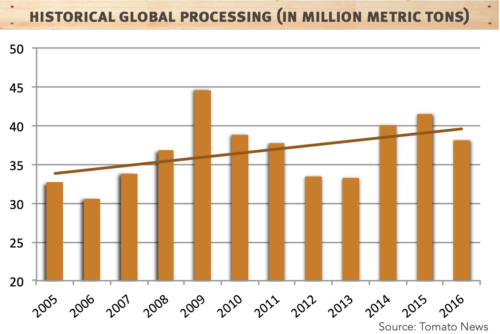 As expected, global processed tomato production in 2016 decreased in volume from 2015 figures. According to the World Processing Tomato Congress, final quantities processed hit 38.047 million metric tonnes (mT), down from 2015 production of 41.374 mT.
As expected, global processed tomato production in 2016 decreased in volume from 2015 figures. According to the World Processing Tomato Congress, final quantities processed hit 38.047 million metric tonnes (mT), down from 2015 production of 41.374 mT. Other AMITOM countries (the largest being Turkey at 2.1 and Iran at 1.15 million mT) saw an overall reduction this season. Turkey’s yields suffered due to rain, falling short of their 2.5 million mT initial forecast.
Other AMITOM countries (the largest being Turkey at 2.1 and Iran at 1.15 million mT) saw an overall reduction this season. Turkey’s yields suffered due to rain, falling short of their 2.5 million mT initial forecast.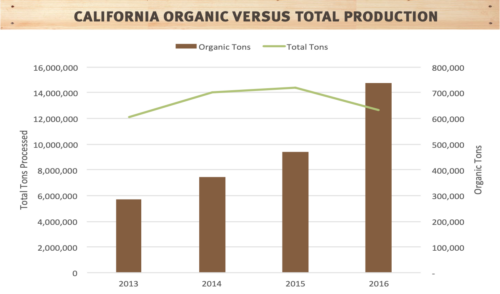 The California processed tomato market in 2016 saw a significant decrease in total production by over 1.7 million tons from 2015. Final production numbers came in at 12,646,979 tons being processed compared to 2015’s final number of 14,361,188.
The California processed tomato market in 2016 saw a significant decrease in total production by over 1.7 million tons from 2015. Final production numbers came in at 12,646,979 tons being processed compared to 2015’s final number of 14,361,188. Rick Palmer is a new addition to the Morning Star colleague family, having just joined us last year. He originally met owner and founder Chris Rufer in 1995 when Rick was the Vice President of Operations for Authentic Specialty Foods and was looking for a co-packer.
Rick Palmer is a new addition to the Morning Star colleague family, having just joined us last year. He originally met owner and founder Chris Rufer in 1995 when Rick was the Vice President of Operations for Authentic Specialty Foods and was looking for a co-packer. Estimates for the 2016 AMITOM processed tomato crop were originally expected to be 300,000 metric tons less than last year with planned tonnage at 17.1 million metric tons (18.8 million short tons) in February. Due to adverse weather conditions, new estimates for the 15 AMITOM countries look to be closer to 16.3 million metric tons (mT).
Estimates for the 2016 AMITOM processed tomato crop were originally expected to be 300,000 metric tons less than last year with planned tonnage at 17.1 million metric tons (18.8 million short tons) in February. Due to adverse weather conditions, new estimates for the 15 AMITOM countries look to be closer to 16.3 million metric tons (mT).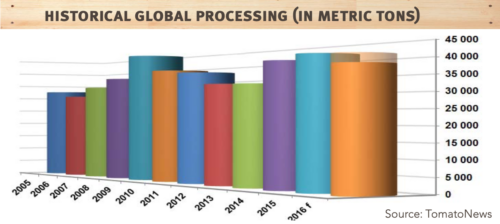 Spain has also fought with weather, getting significant rainfall in April and May that interrupted planting for 15 days. Spain expects a late crop as well as gaps in raw tomato harvesting. The volumes estimated for Spain are around 2.6 million mT.
Spain has also fought with weather, getting significant rainfall in April and May that interrupted planting for 15 days. Spain expects a late crop as well as gaps in raw tomato harvesting. The volumes estimated for Spain are around 2.6 million mT.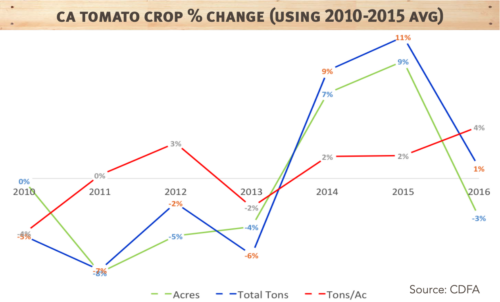 May intentions, recently released by the California Department of Agriculture, show that California’s tomato processors reported that they intend to contract 13 million tons from 262,000 acres this season. This number represents an 11.8% decrease from last year’s final contracted acreage. Contracted production per acre is 49.6 tons/acre, a 1.5 tons/acre increase over the 5-year average and 1.1 tons/acre higher than the prior two years.
May intentions, recently released by the California Department of Agriculture, show that California’s tomato processors reported that they intend to contract 13 million tons from 262,000 acres this season. This number represents an 11.8% decrease from last year’s final contracted acreage. Contracted production per acre is 49.6 tons/acre, a 1.5 tons/acre increase over the 5-year average and 1.1 tons/acre higher than the prior two years.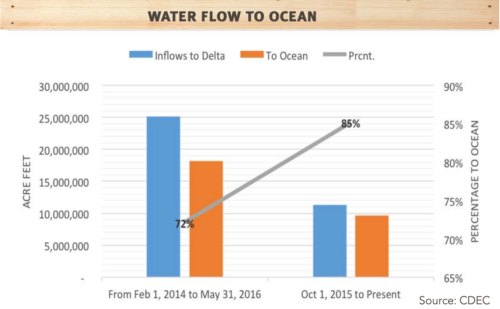 Curtailed pumping remains the primary reason for low water levels in the San Luis Reservoir, despite a good rainfall season. Fresno County, the largest processing tomato county in California is serviced by the Federal Westland Water District. The State Water Project allocation at 60% has improved over the prior year allocation of 20% and Exchange Contractors located in the Los Banos/Firebaugh area are now receiving a 100% allocation this year.
Curtailed pumping remains the primary reason for low water levels in the San Luis Reservoir, despite a good rainfall season. Fresno County, the largest processing tomato county in California is serviced by the Federal Westland Water District. The State Water Project allocation at 60% has improved over the prior year allocation of 20% and Exchange Contractors located in the Los Banos/Firebaugh area are now receiving a 100% allocation this year.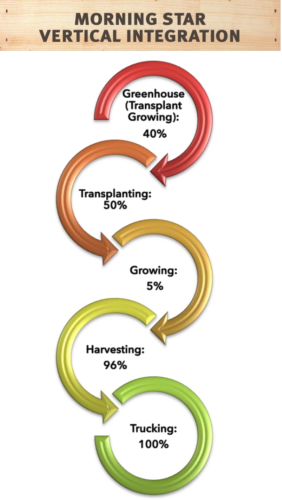 Vertical integration aids in the preparation
Vertical integration aids in the preparation Seedlings take about 40-50 days to mature and be ready for harvest. During this time, our farming partners work hard to maintain the health of the plants in their respective fields. Using drip irrigation, tomato crops are actually one of the most water-efficient crops in California. Given that water has become an increasingly important issue in the state, Morning Star is constantly learning how to better use scarce resources.
Seedlings take about 40-50 days to mature and be ready for harvest. During this time, our farming partners work hard to maintain the health of the plants in their respective fields. Using drip irrigation, tomato crops are actually one of the most water-efficient crops in California. Given that water has become an increasingly important issue in the state, Morning Star is constantly learning how to better use scarce resources.